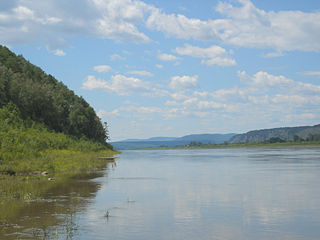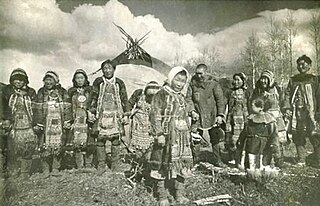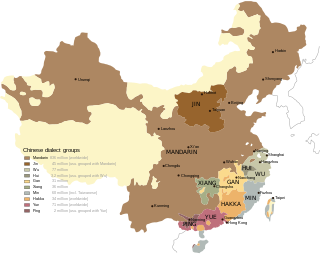Related Research Articles

Chinese is a group of languages spoken natively by the ethnic Han Chinese majority and many minority ethnic groups in China. Approximately 1.35 billion people, or 17% of the global population, speak a variety of Chinese as their first language.

Mandarin is a group of Chinese language dialects that are natively spoken across most of northern and southwestern China. The group includes the Beijing dialect, the basis of the phonology of Standard Chinese, the official language of China. Because Mandarin originated in North China and most Mandarin dialects are found in the north, the group is sometimes referred to as Northern Chinese. Many varieties of Mandarin, such as those of the Southwest and the Lower Yangtze, are not mutually intelligible with the standard language. Nevertheless, Mandarin as a group is often placed first in lists of languages by number of native speakers.

Standard Chinese is a modern standard form of Mandarin Chinese that was first codified during the republican era (1912‒1949). It is designated as the official language of mainland China and a major language in the United Nations, Singapore, and Taiwan. It is largely based on the Beijing dialect. Standard Chinese is a pluricentric language with local standards in mainland China, Taiwan and Singapore that mainly differ in their lexicon. Hong Kong written Chinese, used for formal written communication in Hong Kong and Macau, is a form of Standard Chinese that is read aloud with the Cantonese reading of characters.

The Amur River or Heilong River is a perennial river in Northeast Asia, forming the natural border between the Russian Far East and Northeast China. The Amur proper is 2,824 km (1,755 mi) long, and has a drainage basin of 1,855,000 km2 (716,000 sq mi). If including its main stem tributary, the Argun, the Amur is 4,444 km (2,761 mi) long, making it the world's tenth longest river.

There are hundreds of local Chinese language varieties forming a branch of the Sino-Tibetan language family, many of which are not mutually intelligible. Variation is particularly strong in the more mountainous southeast part of mainland China. The varieties are typically classified into several groups: Mandarin, Wu, Min, Xiang, Gan, Jin, Hakka and Yue, though some varieties remain unclassified. These groups are neither clades nor individual languages defined by mutual intelligibility, but reflect common phonological developments from Middle Chinese.

The Tungusic languages form a language family spoken in Eastern Siberia and Manchuria by Tungusic peoples. Many Tungusic languages are endangered. There are approximately 75,000 native speakers of the dozen living languages of the Tungusic language family. The term "Tungusic" is from an exonym for the Evenk people (Ewenki) used by the Yakuts ("tongus").

The Nanai people are a Tungusic people of East Asia who have traditionally lived along Heilongjiang (Amur), Songhuajiang (Sunggari) and Wusuli River (Ussuri) on the Middle Amur Basin. The ancestors of the Nanai were the Wild Jurchens of northernmost Manchuria.
Evenki, formerly known as Tungus, is the largest member of the northern group of Tungusic languages, a group which also includes Even, Negidal, and the more closely related Oroqen language. The name is sometimes wrongly given as "Evenks". It is spoken by Evenks or Ewenkī(s) in Russia and China.

Jin is a group of varieties of Chinese spoken by roughly 48 million people in northern China, including most of Shanxi province, much of central Inner Mongolia, and adjoining areas in Hebei, Henan, and Shaanxi provinces. The status of Jin is disputed among linguists; some prefer to include it within Mandarin, but others set it apart as a closely related, but separate sister-group.
The Beijing dialect, also known as Pekingese and Beijingese, is the prestige dialect of Mandarin spoken in the urban area of Beijing, China. It is the phonological basis of Standard Chinese, the official language in the People's Republic of China and one of the official languages of Singapore and the Republic of China (Taiwan). Despite the similarity to Standard Chinese, it is characterized by some "iconic" differences, including the addition of a final rhotic 儿; -r to some words. During the Ming, southern dialectal influences were also introduced into the dialect.

Negidals are an Indigenous ethnic group in the Khabarovsk Krai in Russia, who live along the Amgun River and Amur River.

The Sinitic languages, often synonymous with the Chinese languages, are a group of East Asian analytic languages that constitute a major branch of the Sino-Tibetan language family. It is frequently proposed that there is a primary split between the Sinitic languages and the rest of the family. This view is rejected by a number of researchers but has found phylogenetic support among others. The Macro-Bai languages, whose classification is difficult, may be an offshoot of Old Chinese and thus Sinitic; otherwise Sinitic is defined only by the many varieties of Chinese unified by a shared historical background, and usage of the term "Sinitic" may reflect the linguistic view that Chinese constitutes a family of distinct languages, rather than variants of a single language.

Taiwanese Mandarin, frequently referred to as Guoyu or Huayu, is the variety of Mandarin Chinese spoken in Taiwan. A large majority of the Taiwanese population is fluent in Mandarin, though many also speak a variety of Min Chinese known as Taiwanese Hokkien, commonly called Minnanyu, Southern Min, or Hokkien. This language has had a significant influence on Mandarin as spoken on the island.

Sichuanese or Szechwanese (simplified Chinese: 四川话; traditional Chinese: 四川話; Sichuanese Pinyin: Si4cuan1hua4; pinyin: Sìchuānhuà; Wade–Giles: Szŭ4-ch'uan1-hua4), also called Sichuanese/Szechwanese Mandarin (simplified Chinese: 四川官话; traditional Chinese: 四川官話; pinyin: Sìchuān Guānhuà), is a branch of Southwestern Mandarin spoken mainly in Sichuan and Chongqing, which was part of Sichuan Province until 1997, and the adjacent regions of their neighboring provinces, such as Hubei, Guizhou, Yunnan, Hunan and Shaanxi. Although "Sichuanese" is often synonymous with the Chengdu-Chongqing dialect, there is still a great amount of diversity among the Sichuanese dialects, some of which are mutually unintelligible with each other. In addition, because Sichuanese is the lingua franca in Sichuan, Chongqing and part of Tibet, it is also used by many Tibetan, Yi, Qiang and other ethnic minority groups as a second language.

Northeastern Mandarin is the subgroup of Mandarin varieties spoken in Northeast China with the exception of the Liaodong Peninsula and few enclaves along Amur and Ussuri rivers. The classification of Northeastern Mandarin as a separate dialect group from Beijing Mandarin was first proposed by Li Rong, author of the Language Atlas of China, in 1989. However, many researchers do not accept the distinction.
The Nanai language is spoken by the Nanai people in Siberia, and to a much smaller extent in China's Heilongjiang province, where it is known as Hezhe. The language has about 1,400 speakers out of 17,000 ethnic Nanai, but most are also fluent in Russian or Chinese, and mostly use one of those languages for communication.
The Udege language is the language of the Udege people. It is a member of the Tungusic family. It is a moribund language, and classified as critically endangered by the UNESCO Atlas of the World’s Languages in Danger.

The Taz are a Tungusic and Sinitic people who primarily live in Russia. They formed in the 1890s, from intermarriages between Udege, Nanai and Han Chinese. The Taz speak Russian and Northeast Mandarin, with loanwords from Udege and Nanai.

Romanization of Chinese is the use of the Latin alphabet to transliterate Chinese. Chinese uses a logographic script and its characters do not represent phonemes directly. There have been many systems using Roman characters to represent Chinese throughout history. Linguist Daniel Kane wrote, "It used to be said that sinologists had to be like musicians, who might compose in one key and readily transcribe into other keys." The dominant international standard for Standard Mandarin since about 1982 has been Hanyu Pinyin, invented by a group of Chinese linguists, including Zhou Youguang, in the 1950s. Other well-known systems include Wade–Giles and Yale romanization.
References
- ↑ "Tazy" Тазы. Etnic.ru (in Russian). Archived from the original on 2020-09-23. Retrieved 2018-10-12.
- 1 2 3 "Natsionalny sostav naseleniya Rossiyskoy federatsii" Национальный состав населения Российской федерации (Table) (in Russian). Archived from the original (XLS) on 2012-04-24. Retrieved 2019-07-06– via perepis-2010.ru.
- 1 2 "Tazy" Тазы. Assotsiatsiya korennykh malochislennykh narodov Severa, Sibiri i Dalnego Vostoka Rossiyskoy Federatsii (AKMNSS i DV RF)Ассоциация коренных малочисленных народов Севера, Сибири и Дальнего Востока Российской Федерации (АКМНСС и ДВ РФ) (in Russian). Archived from the original on 2020-11-16. Retrieved 2018-10-12.
- 1 2 3 4 5 Kazama, Shinjiro 風間 伸次郎; Podmaskin, V.V. [В.В. Подмаскин] (2002). "Tāzu no gengo to bunka" ターズの言語と文化. In Irimoto, Takashi 煎本孝 (ed.). Tōhoku Ajia sho minzoku no bunka dōtai東北アジア諸民族の文化動態 (in Japanese). Sapporo-shi: Hokkaidō Daigaku Toshokankōkai. ISBN 4-8329-6241-8.
- ↑ "Lingvisty popytayutsya sokhranit yazyk tazov" Лингвисты попытаются сохранить язык тазов. NTVНТВ (in Russian). 2005-10-25. Archived from the original on 2020-08-21. Retrieved 2020-04-04.
